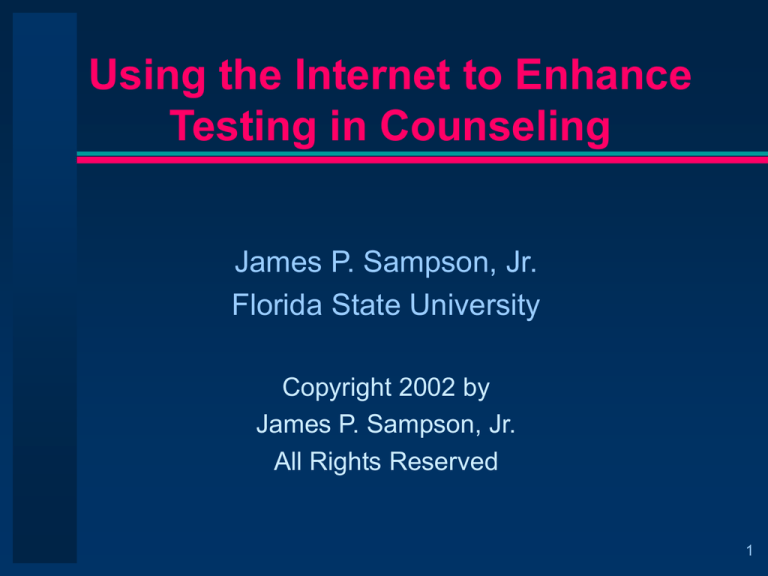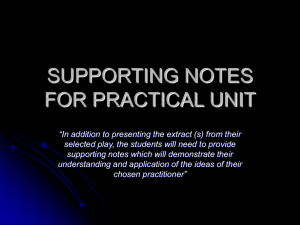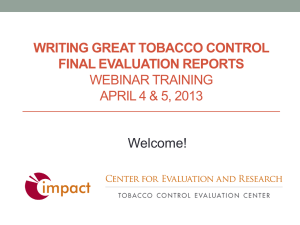
Using the Internet to Enhance
Testing in Counseling
James P. Sampson, Jr.
Florida State University
Copyright 2002 by
James P. Sampson, Jr.
All Rights Reserved
1
Common Elements of Assessment
Selection
Orientation
Administration
Scoring
Interpretation
2
Common Elements of Assessment
Selection
Orientation
Administration
Scoring
Interpretation
10
Test Selection
• Identify potential instruments
related to client needs
• Select measure on technical quality
11
Test Selection
• Download standardized descriptions of
potentially appropriate assessments
• Access links to published test reviews
• Cross-reference assessments with
literature on special populations
• Access links to test publishers to obtain
specimen sets or sample reports
14
Common Elements of Assessment
Selection
Orientation
Administration
Scoring
Interpretation
10
Test Orientation
• Delivered to test taker or
test-taker’s parents or guardians
– computer-assisted instruction
– frequently asked questions (FAQ’s)
• Theory-based or atheoretical
• Description of assessment process
• Orientation to self-assessment adds description of
circumstances where counseling may be needed
19
Common Elements of Assessment
Selection
Orientation
Administration
Scoring
Interpretation
10
Test Administration
• Access tests from password-protected
publisher web sites
• Access self-assessments from free
self-help web sites by completing links
• Access to fee charging self-assessments
require individual or org. prepayment
• E-mail or videoconferencing to seek
assistance when problems occur with
self-help tests
21
Test Administration
• Advantage
– Remote administration - fewer barriers
• Disadvantages
– potentially compromises standardization
– aptitude, achievement, IQ, neurological
– environmental factors (distractions)
– psychological factors (intimidation)
– no opportunity to record deviations
22
Test Administration
• Use of visual images as well as text
• Benefits:
– manipulation tasks - card sorts
– individuals with limited reading ability
• Limitations:
– higher developmental costs
– reactivity to irrelevant data in images
23
Common Elements of Assessment
Selection
Orientation
Administration
Scoring
Interpretation
10
Test Scoring
• Proceeds immediately after
administration
• Self-assessment - no practitioner is
available to explain scoring
• “Black-box” scoring may increase
perceptions of “magical” answers
24
Common Elements of Assessment
Selection
Orientation
Administration
Scoring
Interpretation
14
Test Interpretation
Three aspects of test interpretation:
1. Client Preparation
2. Generalized Test Interpretation
3. Specific Test Interpretation
15
Client Preparation
• Begins in orientation
• Purpose and process of testing
• Repetitive information - boredom poor counselor performance
• Computer effective with repetition
• Counselor provides specific info
16
Specific Test Interpretation
• Counseling: Face-to-face or
distance
• Computer-based test interpretation
17
Specific Test Interpretation
Four options:
1. Computer-based test interpretation
2. Two-way videoconferencing
3. Moderated list servers
4. Moderated computer conferences
5. Follow-up resource links
18
Generalized Test Interpretation
• Basic terminology and concepts
• Repetitive information - bored
counselor - poor performance
• Counselor may appear disinterested
• Knowledge gaps - less prepared
• Better delivered by computer
• Time used for insight and application
19
Computer-Based Test
Interpretation (CBTI)
• Provides an expanded and
consistent knowledge base
• Uses research data and practitioner
experience
• More objective and comprehensive
• Less subject to interpreter bias
20
Types of CBTI
Four types of CBTI:
1. Descriptive
2. Clinician-modeled
(renowned clinician type)
3. Clinician-modeled
(statistical model type)
4. Clinical actuarial
21
CBTI Variation
• Self-assessment
• Counselor-mediated assessment
– Client as consumer
– Practitioner as consumer
22
Self-Assessment
• Designed for little or no practitioner
assistance
• Example: Self-Directed Search
• Both generalized and specific
interpretation
23
Counselor-Mediated Assessment
•
•
•
•
•
•
•
Client as primary consumer
Designed to include practitioner
Example: Strong Interest Inventory
Password-protected web site
Generalized test interpretation
Practitioner intervention
CBTI specific interpretation
24
Counselor-Mediated Assessment
• Practitioner as primary consumer
• Example: MMPI-2
• Password-protected web site
• No generalized test interpretation
• CBTI specific interpretation
• Practitioner intervention
25
Relationship Issues
• Videoconferencing and face-to-face
interaction - similar, but not identical
• Equivalency is not the issue
• Effectiveness is the issue
• Research and development needed
26
Ethical Issues
•
•
•
•
•
•
•
Confidentiality
Attractive, but invalid assessment
Lack of needed counselor intervention
Misuse of, or dependency on, CBTI
Awareness of local circumstances
Limited access to the Internet - SES
Limited auditory and visual privacy
27
Ethical Standards
• National Board for Certified
Counselors - Practice of Internet
Counseling
• National Career Development
Association - Guidelines for the Use
of the Internet for Provision of Career
Information and Planning Services
28
For Additional Information
www.career.fsu.edu/techcenter/
Thank You
29








